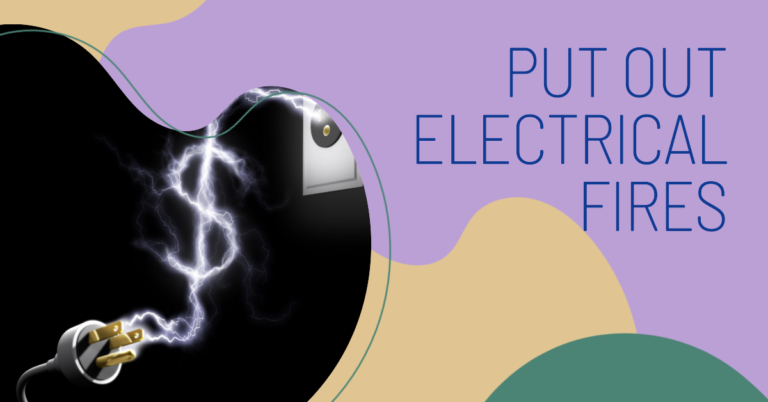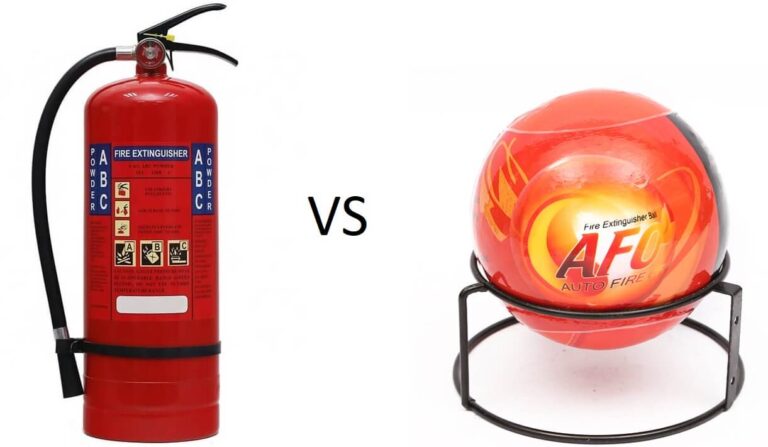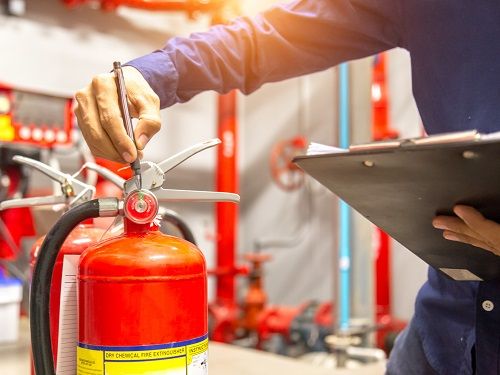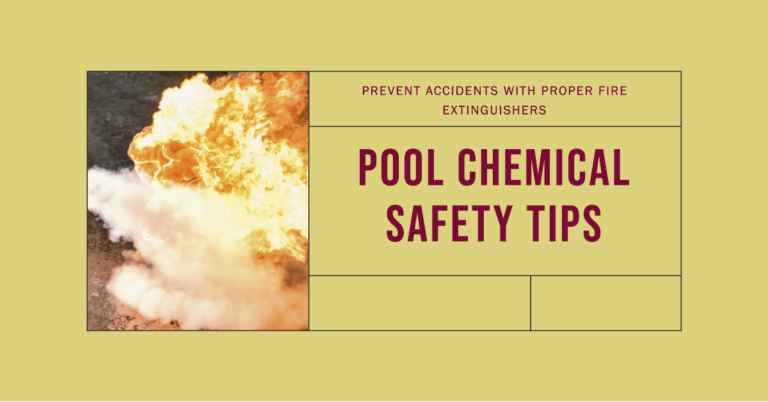Last Updated on October 9, 2023 by Allen
Fire safety at home, and having the right fire extinguisher can make all the difference between a manageable incident and a catastrophic disaster. Fires in residential settings can originate from various sources, and understanding which fire extinguisher for home use is suitable is essential for safeguarding your loved ones and property. In this comprehensive guide, we will explore the different types of fire extinguishers designed for home use, their applications, and how to choose the most suitable one for your specific needs.

Which Fire Extinguisher Is Right for Your Home?
The National Fire Protection Association (NFPA) offers essential guidelines for home fire safety. It is recommended to have primary fire extinguishers in your home. Install a 2-A:10-B: C-rated extinguisher on every level of your home, ensuring they are not more than 40 feet apart. These extinguishers should cover all areas where a fire could potentially originate.
The Importance of Home Fire Safety
Home is where we should feel the safest, but it’s also where fire hazards are most prevalent. Cooking accidents, electrical malfunctions, heating equipment mishaps, and even candles left unattended can lead to fires. Therefore, being well-prepared for potential fire incidents is paramount. A crucial component of this preparedness is having the right fire extinguisher within easy reach.
Types of Fire Extinguishers for Home Use
Fire extinguishers are classified into different classes based on the types of fires they can effectively combat. For home use, the following classes are the most relevant:
- Class A: These extinguishers are suitable for fires involving common combustibles like wood, paper, fabric, and plastics. They are a good choice for most residential fires.
- Class B: Designed for flammable liquids and gases, Class B extinguishers are ideal for kitchen fires involving cooking oils and grease, which can quickly escalate.
- Class C: Electrical fires are a significant concern in homes due to the prevalence of electrical appliances. Class C extinguishers are designed to combat fires involving live electrical equipment.
- Class K: In the kitchen, where grease fires are a real danger, Class K extinguishers are specifically formulated to suppress these high-temperature fires.
What Are The Reasons for Home Fire Extinguishers
- Kitchen Fires: Cooking-related fires are a leading cause of home fires. Having a fire extinguisher in or near the kitchen is crucial, as it allows for quick response to stovetop fires, grease fires, or appliance malfunctions.
- Electrical Hazards: With the increasing number of electrical devices in homes, electrical fires are a significant concern. Electrical fires can originate from faulty wiring, overloaded circuits, or malfunctioning appliances.
- Heating Equipment: Fireplaces, wood stoves, space heaters, and furnaces can pose fire risks if not properly maintained or used incorrectly. Fire extinguishers can help contain fires before they spread.
- Candles and Smoking Materials: Unattended candles and smoking materials are common culprits of home fires. A fire extinguisher provides a means to respond swiftly to such incidents.
- Chemical Storage: Homes may contain flammable chemicals in garages or workshops. Fire extinguishers are essential for addressing fires involving these substances.
How To Right Fire Extinguisher For Your Home
Selecting the appropriate fire extinguisher for your home requires a careful assessment of potential fire risks. Here are some considerations to help you make the right choice:
- Kitchen Safety: Given that the kitchen is a common source of fires at home, it’s advisable to have a Class K fire extinguisher within easy reach. Its specialized agent is highly effective in quelling cooking oil and grease fires.
- Multi-Purpose Extinguishers: For general use and versatility, an ABC-rated fire extinguisher is a solid choice. It covers Class A, B, and C fires, making it suitable for various scenarios.
- Location: Install fire extinguishers in accessible locations where fire risks are higher, such as the kitchen, garage, and electrical panels. Ensure they are mounted at an easily reachable height.
- Regular Maintenance: Like all safety equipment, fire extinguishers require periodic maintenance. Check the pressure gauge, ensure there are no visible signs of damage or leakage, and familiarize yourself with the manufacturer’s guidelines for maintenance.
- Training: Having a fire extinguisher is only effective if you and your family members know how to use it. Consider taking a basic fire extinguisher training course to ensure everyone can respond confidently in case of a fire.
Benefit
- Immediate Response: Fire extinguishers enable immediate action when a fire breaks out. A quick response can prevent a small fire from becoming a large, uncontrollable blaze.
- Property Protection: Using a fire extinguisher effectively can minimize property damage. It can save valuable belongings, prevent structural damage, and reduce repair costs.
- Safety: Fire extinguishers enhance the safety of occupants. They provide a means to escape a fire and reduce the risk of injury or smoke inhalation.
- Peace of Mind: Knowing that you have the means to respond to a fire emergency can provide peace of mind and confidence in your ability to protect your home and loved ones.
Limitations
- Limited Capacity: Fire extinguishers have a finite capacity, typically measured in pounds or liters. They may not be sufficient for large fires, and using them on significant fires can be dangerous.
- Specific Use: Fire extinguishers are designed for specific types of fires (e.g., Class A, B, C, or K). Using the wrong type of extinguisher can be ineffective or even hazardous.
- Maintenance: Fire extinguishers require regular maintenance, including inspections, pressure checks, and recharging or replacement. Neglecting maintenance can result in non-functional extinguishers when needed.
- Training: Effective use of fire extinguishers requires training. Untrained individuals may struggle to operate an extinguisher correctly under the stress of a fire.
Precautions
- Placement: Install fire extinguishers in accessible locations where fire risks are higher, such as the kitchen, garage, and electrical panels. Ensure they are mounted at an easily reachable height.
- Training: Ensure that all family members know how to use a fire extinguisher. Consider taking a basic fire extinguisher training course to learn proper techniques.
- Maintenance: Regularly inspect your fire extinguishers, check the pressure gauge, and follow manufacturer recommendations for maintenance or replacement.
- Know Your Extinguisher: Familiarize yourself with the type of fire extinguisher you have and its intended use. Using the wrong type on a fire can be ineffective or dangerous.
- Escape Plan: While fire extinguishers are valuable, safety should always come first. If a fire cannot be quickly controlled or if it poses a significant risk, evacuate the premises and call the fire department.
Frequently Asked Questions
How often should I replace a home fire extinguisher?
Fire extinguishers generally have a shelf life of 5 to 15 years, depending on the type and manufacturer. Check the manufacturer’s label for the recommended replacement date.
Can I use a Class A extinguisher for kitchen fires?
While Class A extinguishers can be used on some kitchen fires, they may not effectively suppress grease fires. It’s best to have a Class K extinguisher for the kitchen.
Are small, portable extinguishers suitable for home use?
Yes, small portable fire extinguishers are suitable for home use and are often easier to handle. However, ensure they have the appropriate fire class rating for the specific fire risks in your home.
Conclusion
Home fire safety is a shared responsibility, and having the right fire extinguisher is a critical part of that responsibility. Fires can start unexpectedly, and quick action can mean the difference between a minor incident and a devastating loss. By understanding the types of fire extinguishers available for home use, assessing your specific needs, and ensuring proper maintenance and training, you can significantly enhance the safety and security of your home and loved ones. Remember, being prepared today can prevent a potential disaster tomorrow.






